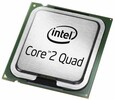Recensione Acer Aspire 7738g
Intel Core 2 Quad Q9000 | NVIDIA GeForce GT 240M | 17.30" | 3.4 kg

L'Intel Core 2 Quad Q9000 è un processore quad core per portatili (con 4 cores) che offre appena 2.0 GHz di velocità clock. La lentezza del core clock comporta prestazioni scarse nelle applicazioni single o dual threaded (come i giochi dal 2008 e successivi).
L'Intel Core 2 Quad Q9000 si basa su due dies Penryn con 3MB di level 2 cache ciascuna, entrambe realizzate in 45nm. Il chip supporta la tecnica "Dual Dynamic Acceleration" per un overclocking automatico dei cores (simile al Turbo Boost). Con questa feature, la Q9000 può effettuare l'overclock su un core, quando tutti gli altri sono in modalità deep sleep (riposo).
Le performance della Core 2 Quad Q9000 non sono molto buone per le applicazioni single threaded a causa della bassa velocità clock di 2 GHz. Pertanto, la maggior parte dei giochi del 2009 gireranno al massimo alla velocità di un 2 GHz dual core Core 2 Duo di categoria inferiore (molto più economico). Solo alcune applicazioni professionali (come il rendering) possono avere prestazioni notevolmente migliori grazie ai quattro cores. Di conseguenza, la Q9000 è adatta solo per un piccolo gruppo di utenti (tutti gli altri dovrebbero scegliere un Core 2 Duo con un clock superiore per lo stesso prezzo).
Il consumo di energia del processore Core Q9000 è relativamente elevato (in quanto consiste di due Core 2 Duo CPU dies da 2 GHz). A causa dei 45 Watt di TDP (16.45 - 74.35 Watt min e max consumo) la CPU è adatta solo per portatili di una certa dimensione con un buon sistema di raffreddamento.
| Nome in codice | Penryn | ||||||||
| Serie | Intel Core 2 Quad | ||||||||
Serie: Core 2 Quad Penryn
| |||||||||
| Clock Rate | 2000 MHz | ||||||||
| Front Side Bus | 1066 | ||||||||
| Level 2 Cache | 6 MB | ||||||||
| Numero di Cores / Threads | 4 / 4 | ||||||||
| Consumo energetico (TDP = Thermal Design Power) | 45 Watt | ||||||||
| Transistor Count | 410 Milioni | ||||||||
| Tecnologia del produttore | 45 nm | ||||||||
| Intervallo di tensione | 0.9-1.25V V | ||||||||
| Dimensione Die | 107 mm2 | ||||||||
| Temperatura massima | 100 °C | ||||||||
| Socket | PGA478 | ||||||||
| Features | Virtualization Technology (VT-x), Trusted Execution, Intel 64, Enhanced Speedstep, SSE4.1 | ||||||||
| 64 Bit | Supporto 64 Bit | ||||||||
| Architecture | x86 | ||||||||
| Prezzo base | $348 U.S. | ||||||||
| Data di annuncio | 01/01/2009 | ||||||||
| Collegamento Prodotto (esterno) | ark.intel.com | ||||||||
Acer Aspire 8935G-904G1TBwn: ATI Mobility Radeon HD 4670, 18.40", 4.6 kg
Recensioni esterne » Acer Aspire 8935G-904G1TBwn
Gateway P-7808u: NVIDIA GeForce 9800M GTS, 17.00", 4.1 kg
Recensioni esterne » Gateway P-7808u
Asus N71: NVIDIA GeForce GT 240M, 17.30", 3.9 kg
Recensioni esterne » Asus N71
Asus N61Vn: NVIDIA GeForce GT 240M, 16.00", 3 kg
Recensioni esterne » Asus N61Vn
Asus Lamborghini VX5 : NVIDIA GeForce GT 130M, 16.10", 3.5 kg
Recensioni esterne » Asus Lamborghini VX5
Asus G51VX: NVIDIA GeForce GTX 260M, 15.60", 3.3 kg
Recensioni esterne » Asus G51VX
Asus W90Vp: ATI Mobility Radeon HD 4870 X2, 18.40", 6.1 kg
Recensioni esterne » Asus W90Vp
HP Pavilion dv7-2270us: ATI Mobility Radeon HD 4650, 17.30", 3.6 kg
Recensioni esterne » HP Pavilion dv7-2270us
Asus G72GX: NVIDIA GeForce GTX 260M, 17.30", 4.1 kg
Recensioni esterne » Asus G72GX
Fujitsu Amilo Xi3670: NVIDIA GeForce 9600M GT, 18.40", 4 kg
Recensioni esterne » Fujitsu Amilo Xi3670
Acer Aspire 8935G: ATI Mobility Radeon HD 4670, 18.40", 4.6 kg
Recensioni esterne » Acer Aspire 8935G
Acer Aspire 7738g: NVIDIA GeForce GT 240M, 17.30", 3.4 kg
Recensioni esterne » Acer Aspire 7738g
Packard Bell iPower GX-Q-030: NVIDIA GeForce 9800M GT, 17.00", 4.1 kg
Recensioni esterne » Packard Bell iPower GX-Q-030
MSI GT628Q: NVIDIA GeForce GTS 160M, 15.40", 2.8 kg
Recensioni esterne » MSI GT628Q
MSI GT628: NVIDIA GeForce GTS 160M, 15.40", 2.8 kg
Recensioni esterne » MSI GT628
» Confronto CPU Mobile
Confronto di tutte le serie di CPU mobile
» Processori Mobile - Elenco Benchmark
Elenco Benchmark di tutte le CPUs conosciute, usate nei portatili (CPUs desktop e portatili)
I nostri Top 10
» Top 10 Portatili Multimedia
» Top 10 Portatili Gaming
» Top 10 Portatili Gaming Leggeri
» Top 10 Portatili da Ufficio e Business economici
» Top 10 Portatili Premium da Ufficio/Business
» Top 10 Portatili sotto i 300 Euro
» Top 10 Portatili sotto i 500 Euro
» Top 10 dei Portatili Workstation
» Top 10 Subnotebooks
» Top 10 Ultrabooks
» Top 10 Convertibili
» Top 10 Tablets
» Top 10 Tablets Windows
» Top 10 Smartphones